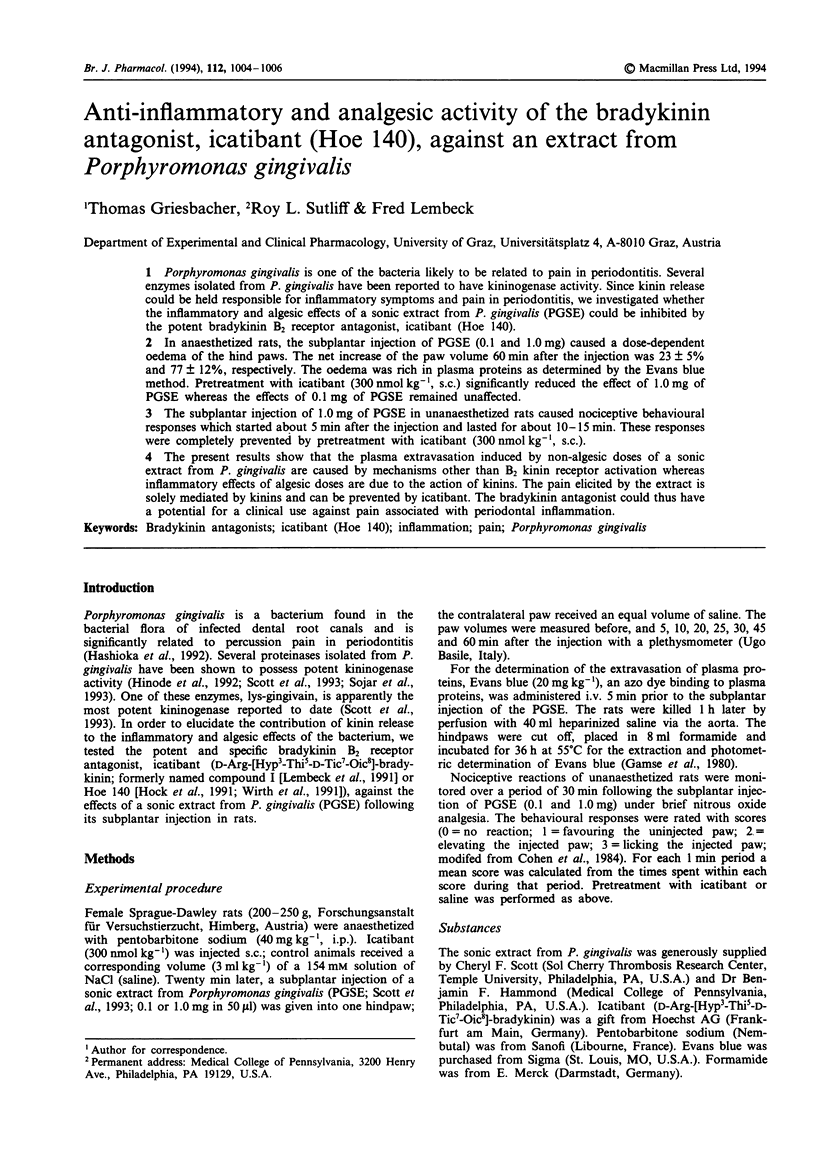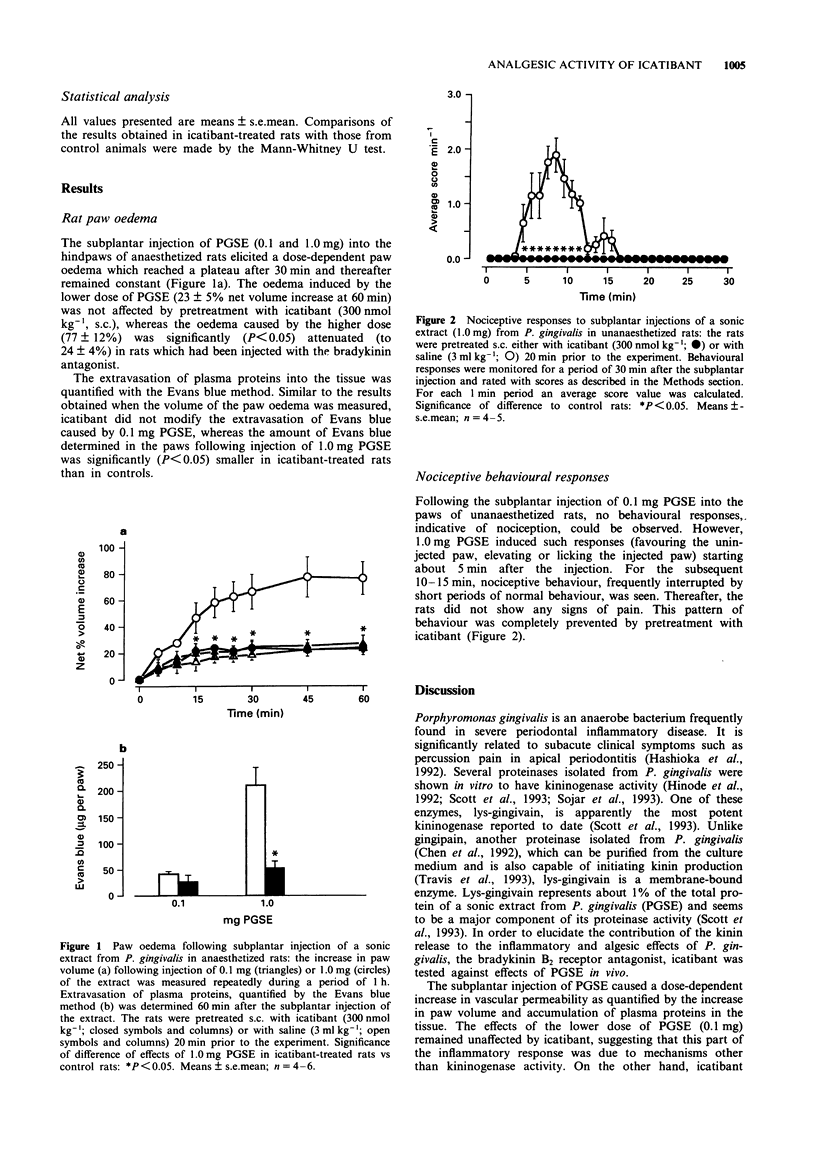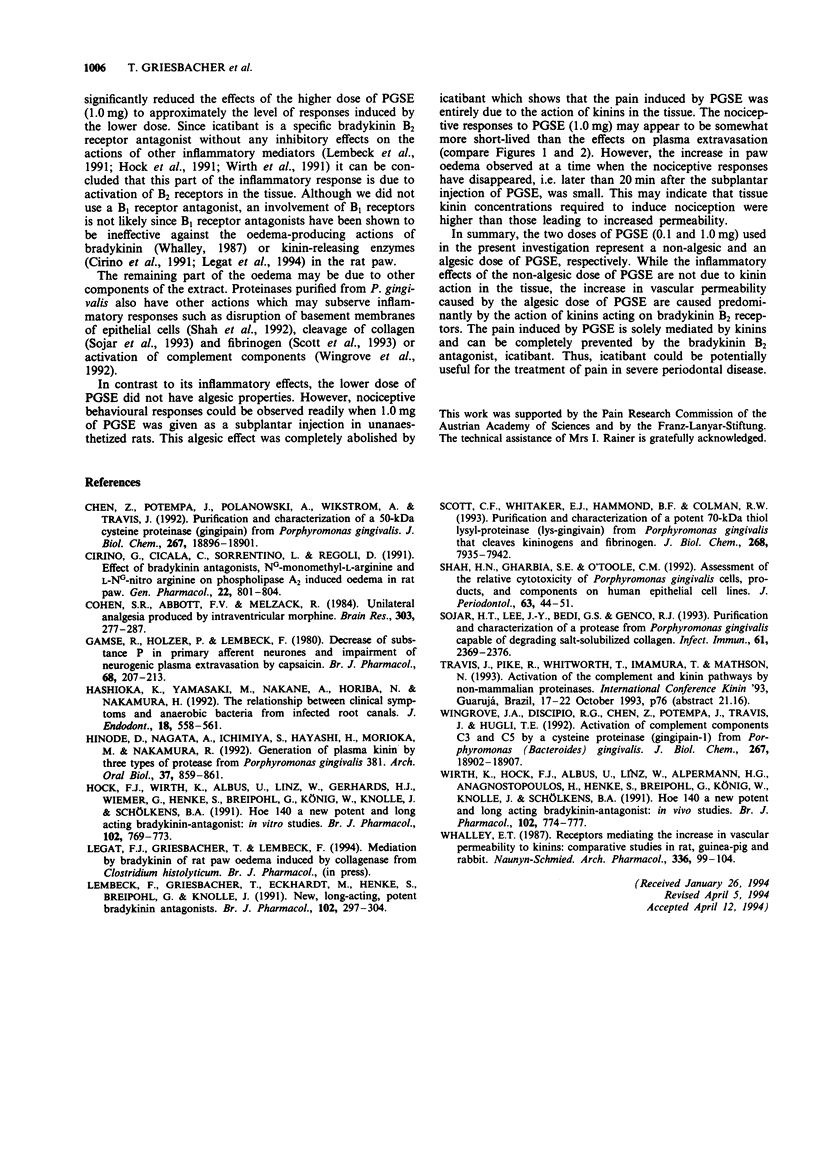Abstract
1. Porphyromonas gingivalis is one of the bacteria likely to be related to pain in periodontitis. Several enzymes isolated from P. gingivalis have been reported to have kininogenase activity. Since kinin release could be held responsible for inflammatory symptoms and pain in periodontitis, we investigated whether the inflammatory and algesic effects of a sonic extract from P. gingivalis (PGSE) could be inhibited by the potent bradykinin B2 receptor antagonist, icatibant (Hoe 140). 2. In anaesthetized rats, the subplantar injection of PGSE (0.1 and 1.0 mg) caused a dose-dependent oedema of the hind paws. The net increase of the paw volume 60 min after the injection was 23 +/- 5% and 77 +/- 12%, respectively. The oedema was rich in plasma proteins as determined by the Evans blue method. Pretreatment with icatibant (300 nmol kg-1, s.c.) significantly reduced the effect of 1.0 mg of PGSE whereas the effects of 0.1 mg of PGSE remained unaffected. 3. The subplantar injection of 1.0 mg of PGSE in unanaesthetized rats caused nociceptive behavioural responses which started about 5 min after the injection and lasted for about 10-15 min. These responses were completely prevented by pretreatment with icatibant (300 nmol kg-1, s.c.). 4. The present results show that the plasma extravasation induced by non-algesic doses of a sonic extract from P. gingivalis are caused by mechanisms other than B2 kinin receptor activation whereas inflammatory effects of algesic doses are due to the action of kinins. The pain elicited by the extract is solely mediated by kinins and can be prevented by icatibant.(ABSTRACT TRUNCATED AT 250 WORDS)
Full text
PDF


Selected References
These references are in PubMed. This may not be the complete list of references from this article.
- Chen Z., Potempa J., Polanowski A., Wikstrom M., Travis J. Purification and characterization of a 50-kDa cysteine proteinase (gingipain) from Porphyromonas gingivalis. J Biol Chem. 1992 Sep 15;267(26):18896–18901. [PubMed] [Google Scholar]
- Cirino G., Cicala C., Sorrentino L., Regoli D. Effect of bradykinin antagonists, NG-monomethyl-L-arginine and L-NG-nitro arginine on phospholipase A2 induced oedema in rat paw. Gen Pharmacol. 1991;22(5):801–804. doi: 10.1016/0306-3623(91)90209-o. [DOI] [PubMed] [Google Scholar]
- Cohen S. R., Abbott F. V., Melzack R. Unilateral analgesia produced by intraventricular morphine. Brain Res. 1984 Jun 15;303(2):277–287. doi: 10.1016/0006-8993(84)91214-9. [DOI] [PubMed] [Google Scholar]
- Gamse R., Holzer P., Lembeck F. Decrease of substance P in primary afferent neurones and impairment of neurogenic plasma extravasation by capsaicin. Br J Pharmacol. 1980 Feb;68(2):207–213. doi: 10.1111/j.1476-5381.1980.tb10409.x. [DOI] [PMC free article] [PubMed] [Google Scholar]
- Hashioka K., Yamasaki M., Nakane A., Horiba N., Nakamura H. The relationship between clinical symptoms and anaerobic bacteria from infected root canals. J Endod. 1992 Nov;18(11):558–561. doi: 10.1016/S0099-2399(06)81214-8. [DOI] [PubMed] [Google Scholar]
- Hinode D., Nagata A., Ichimiya S., Hayashi H., Morioka M., Nakamura R. Generation of plasma kinin by three types of protease isolated from Porphyromonas gingivalis 381. Arch Oral Biol. 1992 Oct;37(10):859–861. doi: 10.1016/0003-9969(92)90120-w. [DOI] [PubMed] [Google Scholar]
- Hock F. J., Wirth K., Albus U., Linz W., Gerhards H. J., Wiemer G., Henke S., Breipohl G., König W., Knolle J. Hoe 140 a new potent and long acting bradykinin-antagonist: in vitro studies. Br J Pharmacol. 1991 Mar;102(3):769–773. doi: 10.1111/j.1476-5381.1991.tb12248.x. [DOI] [PMC free article] [PubMed] [Google Scholar]
- Lembeck F., Griesbacher T., Eckhardt M., Henke S., Breipohl G., Knolle J. New, long-acting, potent bradykinin antagonists. Br J Pharmacol. 1991 Feb;102(2):297–304. doi: 10.1111/j.1476-5381.1991.tb12169.x. [DOI] [PMC free article] [PubMed] [Google Scholar]
- Scott C. F., Whitaker E. J., Hammond B. F., Colman R. W. Purification and characterization of a potent 70-kDa thiol lysyl-proteinase (Lys-gingivain) from Porphyromonas gingivalis that cleaves kininogens and fibrinogen. J Biol Chem. 1993 Apr 15;268(11):7935–7942. [PubMed] [Google Scholar]
- Shah H. N., Gharbia S. E., O'Toole C. M. Assessment of the relative cytotoxicity of Porphyromonas gingivalis cells, products, and components on human epithelial cell lines. J Periodontol. 1992 Jan;63(1):44–51. doi: 10.1902/jop.1992.63.1.44. [DOI] [PubMed] [Google Scholar]
- Sojar H. T., Lee J. Y., Bedi G. S., Genco R. J. Purification and characterization of a protease from Porphyromonas gingivalis capable of degrading salt-solubilized collagen. Infect Immun. 1993 Jun;61(6):2369–2376. doi: 10.1128/iai.61.6.2369-2376.1993. [DOI] [PMC free article] [PubMed] [Google Scholar]
- Whalley E. T. Receptors mediating the increase in vascular permeability to kinins: comparative studies in rat, guinea-pig and rabbit. Naunyn Schmiedebergs Arch Pharmacol. 1987 Jul;336(1):99–104. doi: 10.1007/BF00177758. [DOI] [PubMed] [Google Scholar]
- Wingrove J. A., DiScipio R. G., Chen Z., Potempa J., Travis J., Hugli T. E. Activation of complement components C3 and C5 by a cysteine proteinase (gingipain-1) from Porphyromonas (Bacteroides) gingivalis. J Biol Chem. 1992 Sep 15;267(26):18902–18907. [PubMed] [Google Scholar]
- Wirth K., Hock F. J., Albus U., Linz W., Alpermann H. G., Anagnostopoulos H., Henk S., Breipohl G., König W., Knolle J. Hoe 140 a new potent and long acting bradykinin-antagonist: in vivo studies. Br J Pharmacol. 1991 Mar;102(3):774–777. doi: 10.1111/j.1476-5381.1991.tb12249.x. [DOI] [PMC free article] [PubMed] [Google Scholar]


